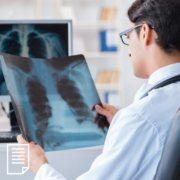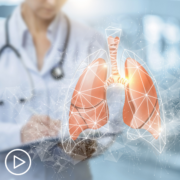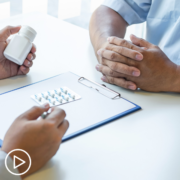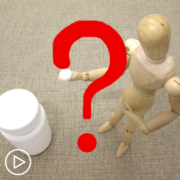Lung Cancer Treatment: How Do Targeted Therapies Work?
Lung Cancer Treatment: How Do Targeted Therapies Work? from Patient Empowerment Network on Vimeo.
Lung cancer specialist, Dr. Tejas Patil, explains how targeted therapies work to fight lung cancer, including how these treatments are administered and which patients they may be right for.
Dr. Tejas Patil is an academic thoracic oncologist at the University of Colorado Cancer Center focused on targeted therapies and novel biomarkers in lung cancer. Learn more about Dr. Patil, here.
Download Program Resource Guide
See More From INSIST! Lung Cancer
Related Programs:

Deciding on a Lung Cancer Treatment? Essential Testing for Optimal Care |

How Can You Access Personalized Lung Cancer Treatment? Resource Guide |

|
Transcript:
Dr. Patil:
We have learned that there are several cancers, such as breast and colorectal cancer, where there’s clear evidence that there are hereditary genes that increase an individual’s risk for developing cancer. I personally prefer the term molecular testing over genetic testing as this emphasizes that we’re looking for specific mutations that are really acquired during a patient’s lifetime and typically not inherited.
Katherine:
How do genetic mutations in lung cancer affect treatment options for patients?
Dr. Patil:
Well, the finding of a molecular alteration, or an oncogene, is really important for a patient with lung cancer because it offers a unique class of therapy that the patient would not have had otherwise. Finding a mutation is important because it allows patients to have treatment options outside of traditional chemotherapy or immunotherapy.
Katherine:
Dr. Patil, how do targeted therapies work?
Dr. Patil:
Targeted therapies are interesting. They work by specifically targeting and blocking specific mutations in lung cancer, and so it’s kind of like a lock and key model. By blocking the binding site of a mutation, the treatment actually prevents that cancer cell from properly functioning, and this in turn causes the cancer cell to be unable to divide, unable to grow, and ultimately results in cancer cell death. Targeted therapies typically come in either a form of a pill.
That’s the most common way that patients take targeted therapies.
As an aside, I will note that there’s a very unique class of targeted therapies called antibody-drug conjugates. These are really fascinating molecules. They are treatments that are consistent, but very complex, bioengineered structures, so what you have is an antibody that targets some protein on the surface of a cancer cell, a mutation.
This antibody is linked to a chemotherapy payload, and so it allows for very potent chemotherapy to be delivered effectively and selectively to cancer cells, sort of like a Trojan Horse effect where the antibody finds the cancer cell, goes inside the cancer cell, and once the whole structure is inside the cell, that’s when the chemotherapy is released.
Therefore, it’s a way of giving chemotherapy in a more targeted way, and there are several of these in clinical trials right now.
Katherine:
Well, you mentioned patients taking pills. What other treatment regimens are there for the targeted therapies?
Dr. Patil:
For targeted therapies, the most common is a pill. The schedule depends on the mutation, so it can sometimes be once a day or twice a day. And then, there are IV treatments that we see, and that is the antibody drug conjugate that I’m referring to where patients will have to go to a infusion center to get those. But to my knowledge, most of those are still in the context of a clinical trial, and so I think it’ll be a while before we start seeing them commercially licensed.









